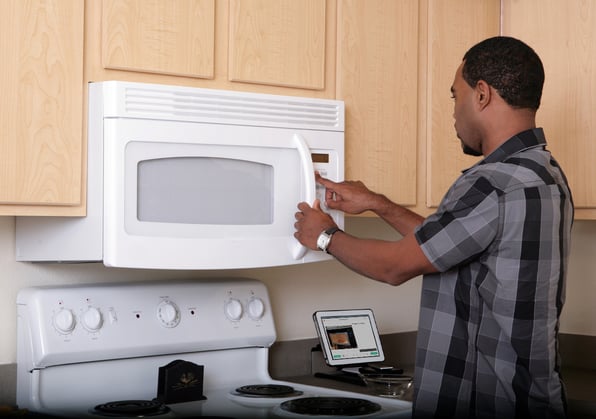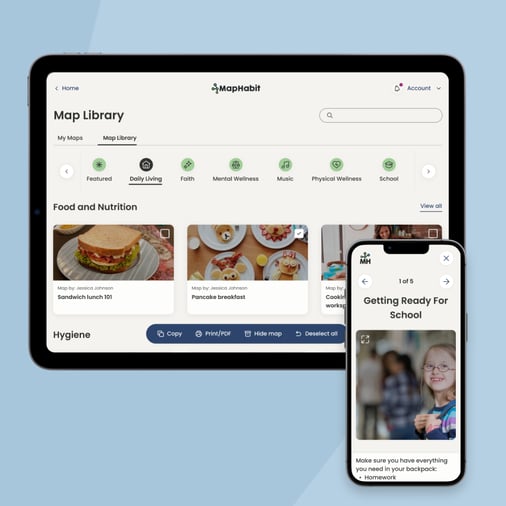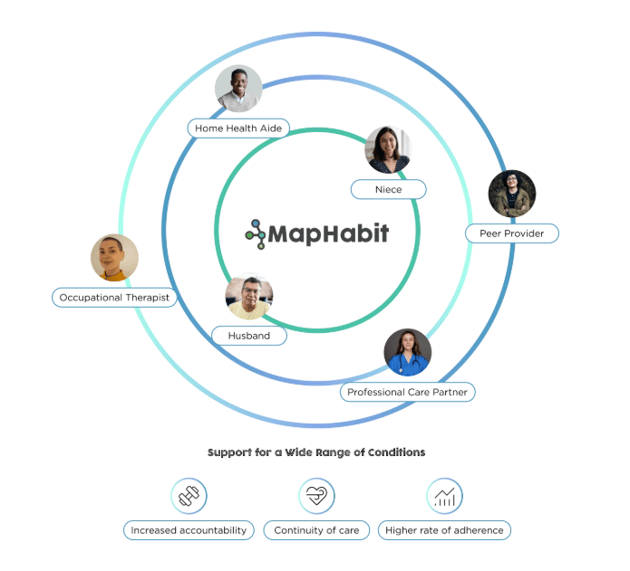MapHabit for Providers: Making Therapy More Effective (and Easier for You)

Imagine a teenager with Down syndrome learning to cook a simple meal. Without access to the necessary resources and supports, an everyday task like this can be overwhelming or stressful. However, with step-by-step visual maps available to guide them through each action—open the fridge, gather ingredients, turn on the stove—they not only master the task but also gain confidence and independence. For therapists and Board Certified Behavioral Analysts (BCBAs), visual tools like these reduce the lift of session prep, extend skill practice into daily life, and help you measure progress more efficiently.
As a provider supporting people with intellectual and developmental disabilities (IDD), you understand how powerful structure and consistency can be for successful outcomes. Everyday routines like brushing teeth, taking medication, or participating in community activities are opportunities to build independence and increase plan adherence. However, organizing routines into manageable steps, reinforcing them across environments, and tracking progress can be challenging.
By breaking tasks into clear, step-by-step audio-visual and video guides, or “maps,” MapHabit’s assistive technology (AT) makes life easier for the people you work with (and for you).
Bridge the Gap Between Therapy and Everyday Life
You work hard to teach a skill, but too often, it disappears in between sessions. MapHabit closes that gap. It goes wherever the person goes: at home, school, work, or in the community. By digitizing skill-building plans into progressive visual maps, each task is broken down and supported with images, equipping individuals and their families to build habits that last.
MapHabit assists with everything from medication reminders to grocery lists and hygiene activities, helping individuals manage daily life with more continuity. These long-term visual supports also grow with each person, adapting to changing therapeutic and healthcare needs and providing lasting guidance at every stage of life.

For providers, MapHabit delivers valuable feedback on map usage, offering visibility into how individuals are interacting with their routines. This extends the impact of your work with the individuals you support and fosters stronger provider-client relationships.
See the Impact
Providers using MapHabit often see measurable progress evolve into meaningful daily independence. One individual user with Down syndrome shared:
Addie, Age 8
Self-Advocate
“I wash my face, brush my teeth, and put the towel up to dry [with MapHabit]. I want to do more maps!"
For therapists and BCBAs, this kind of feedback underscores the value of visual mapping tools and assistive technology. Providers using MapHabit report fewer repeated lessons and smoother session planning. Visual mapping supports positive development by strengthening confidence and promoting continued growth outside of sessions, leading to further independence.
Personalize and Streamline Care

We understand that learning styles vary and navigating daily life can be challenging without the right resources and supports. Grounded in neuroscience and personalized strategies, MapHabit helps users build skills and create structure, transforming everyday challenges into opportunities for success.
Instead of rebuilding visuals every session, you can create your own templates or pull from more than 1,000 customizable MapHabit examples. Once built, these templates can be easily adapted for different clients or goals, helping you align supports directly with each person’s therapy plan while saving time and effort. This flexibility improves efficiency and drives higher engagement so your clients stay on track, and you maximize each session.
Connect the Circle of Support
Maintaining integrated care coordination can be challenging when many caregivers are involved. MapHabit gives everyone—families, teachers, care managers—access to the same information about an individual’s routines and goals. For example, a therapist can update a morning routine map, and the change is visible to a parent at home and a teacher at school, keeping everyone on the same page. With unlimited users in the Circle of Support, the entire care network stays connected and informed, reducing confusion and creating a seamless experience for both providers and individuals.

From setup through training, our team provides one-on-one guidance so individuals and caregivers can unlock the full benefits of MapHabit from day one. That means fewer urgent calls from caregivers unsure of next steps.
Reduce Costs, Improve Outcomes

Assistive technology helps reduce costs by lowering hospital readmissions, preventing emergency visits, and limiting reliance on high-cost interventions. MapHabit’s tools streamline operations and deliver significant savings. For providers, this translates to less administrative burden and the opportunity to provide higher-quality support, resulting in enhanced outcomes.
Empower Individuals with IDD
The need for inclusive, cognitive support technology is greater than ever as we learn more about IDD. MapHabit extends your expertise, turning your therapy plans into daily tools families can actually use. You lead the process, working with individuals and their families to design plans that are specific to their needs, choose the reinforcers, and set the goals. Together with your guidance and MapHabit’s tools, individuals experience improvement in overall health and enjoy a higher quality of life.
Add MapHabit to Your Therapy Toolkit
Join the growing number of therapists and BCBAs using MapHabit to simplify therapy, strengthen outcomes, and promote autonomy. Reach out to the MapHabit team today to see how visual mapping can elevate your practice and the lives of the people you support.



